Slide 10

Traditional practice and recommendations for change...
Slide 11
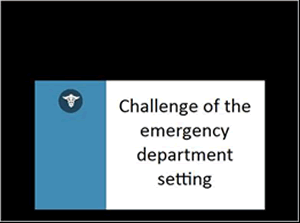
Challenge of the emergency department setting
Multiteam Survey
Periodically, you will be asked a survey question to compare your current practice with that of our larger sample of emergency nurses.
Select the icon to learn more about the survey.
Answer the survey question and select "Submit".
Slide 12
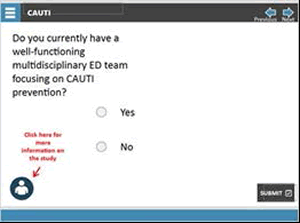
Do you currently have a well-functioning multidisciplinary ED team focusing on CAUTI prevention? (select yes or no)
Slide 13
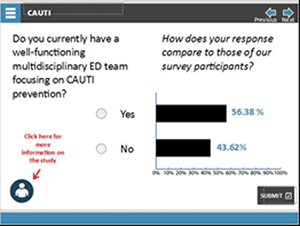
Do you currently have a well-functioning multidisciplinary ED team focusing on CAUTI prevention? (select yes or no)
How does your response compare to those of our survey participants?
Bar chart showing that 56.38 % responded yes, and 43.62 % responded no.
Slide 14
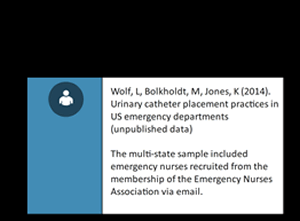
Wolf, L, Bolkholdt, M, Jones, K (2014). Urinary catheter practices in US emergency departments (unpublished data).
The multi-state sample included emergency nurses recruited from the membership of the Emergency Nurses Association via email.
Challenges in the ED
What are some of the challenges related to CAUTI reduction in the ED setting? Enter these challenges onto the clipboard on the left of your screen. After you have finished, select "Submit".
Slide 15
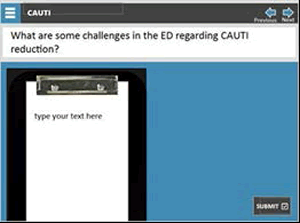
What are some challenges in the ED regarding CAUTI reduction? Type your text here.
Your answers might have included:
- Rapidly shifting priorities
- Quick turnover of patients
- An environment that can easily become chaotic
- Patients representing a wide range of ages and developmental stages
- And patients presenting with an unclear diagnosis and symptom etiology
Slide 16
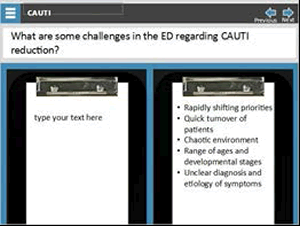
What are some challenges in the ED regarding CAUTI reduction?
- Rapidly shifting priorities.
- Quick turnover of patients.
- Chaotic environment.
- Range of ages and developmental stages.
- Unclear diagnosis and etiology symptoms.
Driving Patient Care
Who is driving the care in the ED? Is it nurses? Emergency providers? Surgeons? Hospitalists? Intensivists? Patients?
Emergency care is team driven, but it is often the nurse who suggests the need for an indwelling urinary catheter, or who can suggest alternatives.
Slide 17
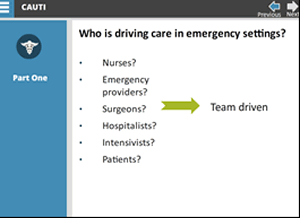
Who is driving care in emergency settings?
- Nurses?
- Emergency providers?
- Surgeons?
- Hospitalists?
- Intensivists?
- Patients?
To the right of the list is a green arrow pointing right from list to term "Team driven".
Slide 18
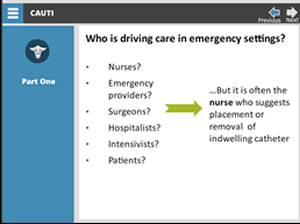
Who is driving care in emergency settings?
- Nurses?
- Emergency providers?
- Surgeons?
- Hospitalists?
- Intensivists?
- Patients?
To the right of the list is a green arrow pointing right from list to term "...But it is often the nurse who suggests placement or removal of indwelling catheter".
Nursing Study
A recent nursing study explored individual and environmental factors that positively and negatively affect clinical decision-making regarding urinary catheter placement and maintenance.
Select the icon for the article’s citation.
Slide 19

A qualitative study on nurses' perceptions.
"To Foley or Not to Foley: Emergency Nurses' Perceptions of Clinical Decision Making in the Use of Urinary Catheters in the Emergency Department."
Slide 20
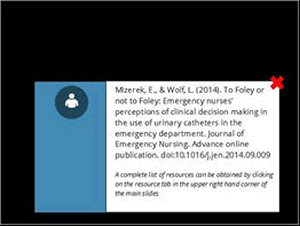
Mizerek E, & Wolf L. (2014) To Foley or not to Foley: Emergency nurses' perceptions of clinical decision making in the use of urinary catheters in the emergency department. Journal of Emergency Nursing. Advance online publication. 2014.
A complete list of resources can be obtained by selecting the Resource tab in the upper right hand corner of the main slides.
Employing a qualitative exploratory design, the researchers conducted focus groups with 23 English-speaking emergency nurses recruited from attendance at a regional conference.
In the Mizerek and Wolf study, nurses were asked questions including:
- What are the conditions under which the decision to place a urinary catheter is made?
- Who is involved in this decision; how is the decision communicated?
- If there is disagreement about the decision, how is it resolved?
- Are protocols useful?
Slide 21
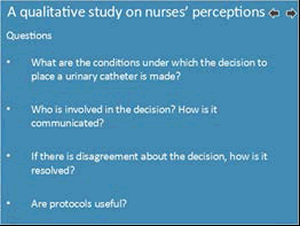
A qualitative study on nurses' perceptions
Questions:
- What are the conditions under which the decision to place a urinary catheter is made?
- Who is involved in the decision? How is it communicated?
- If there is disagreement about the decision, how is it resolved?
- Are protocols useful?
The study identified several themes, including ownership, education and competencies, communication, barriers, and facilitators.
Slide 22
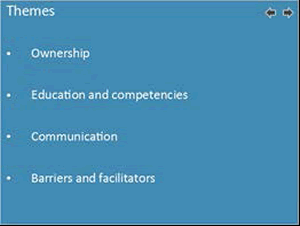
Themes
- Ownership
- Education and competencies
- Communication
- Barriers and facilitators
In this module, we have selected several responses from the focus group and will periodically display them on the screen, as shown here. First you will see the theme, followed by a quote from one of the focus group members.
Note: Quotes represent responses from our focus group members regarding catheter placement and decision-making in the ED.
Slide 23

Theme: Ownership
Urinary catheter placement... "
...under the purview of nursing judgment..."
"Ninety percent of the time I'm using my nursing judgment."
Perceived Role of Nurses
In the qualitative study conducted by Mizerek and Wolf, nurses reported “ownership” of the function of elimination. Nurses stated that care related to elimination fell under the purview of nursing judgment, even when a provider order was obtained after the fact. Providers are described as accepting the clinical judgment of emergency nurses with regard to catheter placement.
Almost 97 percent of nurses surveyed reported that, in their EDs, RNs are responsible for insertion of indwelling catheters.
Select the icon to learn more about this study.
Slide 24
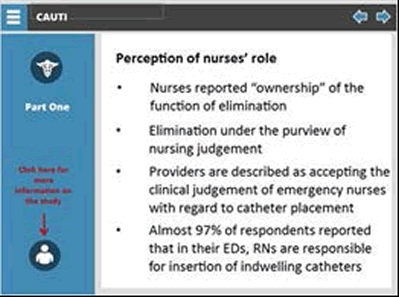
Perception of nurses' role
- Nurses reported "ownership" of the function of elimination.
- Elimination under the purview of nursing judgment.
- Providers are described as accepting the clinical judgment of emergency nurses with regard to catheter placement.
- Almost 97% of respondents reported that in their EDs, RNs are responsible for insertion of indwelling catheters
Slide 25
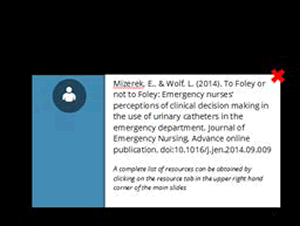
Mizerek E, & Wolf L. (2014) To Foley or not to Foley: Emergency nurses' perceptions of clinical decision making in the use of urinary catheters in the emergency department. Journal of Emergency Nursing. Advance online publication. 2014.
A complete list of resources can be obtained by selecting the Resource tab in the upper right hand corner of the main slides.
Perceived Role of ED Nurse
At the initial patient encounter, and as the patient moves along the continuum of care, the emergency nurse makes clinical decisions that affect patient safety and the efficacy, efficiency, and cost-effectiveness of care.
These decisions involve problem identification, acuity assignment, acquisition of resources, and patient advocacy.
When looking at this from a CAUTI perspective, some relevant questions are:
Problem identification
- What is the chief complaint?
- Is it related to the urinary tract?
- Is it related to volume (dehydration, hypovolemic shock, fluid overload, hypertension, congestive heart failure)?
Acuity assignment
- What is the urgency to be seen?
- What is the urgency for diagnostic testing (blood and urine laboratory values)?
- What is the need for ongoing monitoring (intake and output, response to fluid resuscitation)?
Need for resources
- What teams need to be activated (specialists, code team, trauma team, brain injury team)?
- What protocols need to be instituted (sepsis, stroke, myocardial infarction)?
Patient advocacy
- What are the expressed needs of the patient and how do they balance with the needs of treatment?
Slide 26
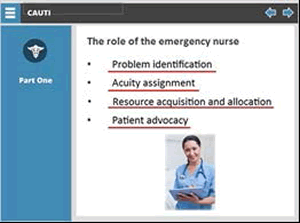
The role of the emergency nurse
- Problem identification.
- Acuity assignment
- Resource acquisition and allocation.
- Patient advocacy.
Protocols Survey
Answer the following survey question as it relates to your institution, then select "Submit".
Slide 27
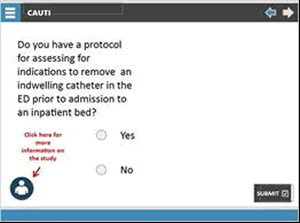
Do you have a protocol for assessing for indications to remove an indwelling catheter in the ED prior to admission to an inpatient bed?
(select yes or no)
Slide 28
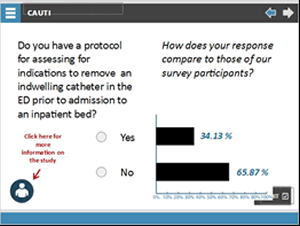
Do you have a protocol for assessing for indications to remove an indwelling catheter in the ED prior to admission to an inpatient bed?
(select yes or no)
How does your response compare to those of our survey participants?
Bar chart showing response: 34.13% clicked Yes, 65.87% clicked No.
Slide 29
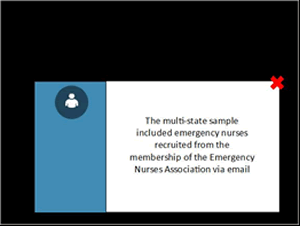
The multistate sample included emergency nurses recruited from the membership of the Emergency Nurses Association via email.
Catheter Removal Survey
Answer the following survey question as it relates to your institution, then select "Submit".
Slide 30
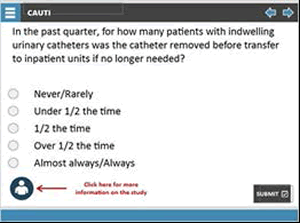
In the past quarter, for how many patients with indwelling urinary catheters was the catheter removed before transfer to inpatient units if no longer needed?
Select a response: Never/Rarely, Under 1/2 the time, 1/2 the time, Over 1/2 the time, or Almost always/Always
How does your practice align with that of other emergency nurses and departments?
The interesting fact to note here is not that patients are being admitted to inpatient units with urinary catheters. Rather, nurse respondents reported that they knew the patient no longer needed a urinary catheter, but removal was not considered. They weren’t making the connection that they could be the initiator of this practice change by advocating for removal of unnecessary urinary catheters.
Slide 31
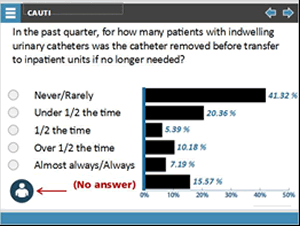
In the past quarter, for now many patients with indwelling urinary catheters was the catheter removed before transfer to inpatient units if no longer needed?
Bar chart shows results which are: Never/Rarely 41.32%, Under 1/2 the time 20.36%, 1/2 the time 5.39%, Over 1/2 the time 10.18%, and Almost always/Always 15.57%.
Slide 32
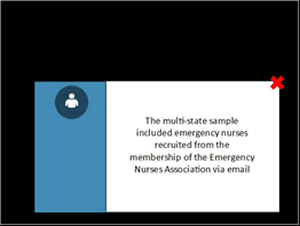
The multistate sample included emergency nurses recruited from the membership of the Emergency Nurses Association via email.
Obstacles to Change
Nurses are aware of the next step in the process of reducing CAUTIs, yet our survey results indicate that real practice change gets held up. What are the obstacles to practice change? Nurses surveyed reported the following:
- Inadequate training and observation.
- Fighting the status quo. It’s what we have always done.
- Questions around ownership: Whose problem is it?
- Handoffs that lack uniformity and consistency allow important information to be missed.
- Uninformed assumptions and a breakdown of communication.
Finally, in the chaotic environment of the ED, CAUTI takes low priority. After all, the patient will be gone from the ED in a short while and nurses don’t directly observe any complications.
Slide 33
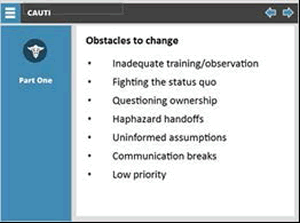
Obstacles to change
- Inadequate training/observation
- Fighting the status quo
- Questioning ownership
- Haphazard handoffs
- Uninformed assumptions
- Communication breaks
- Low priority
Slide 34
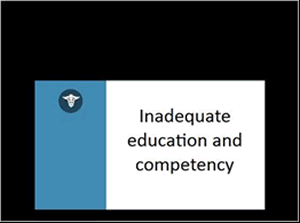
Inadequate education and competency
This quote represents focus group member responses to questions about education and competency in CAUTI reduction and catheter insertion.
Slide 35

Theme: Education and competencies
"We have to demonstrate competency for the fingerstick but not for the Foley."
Slide 36
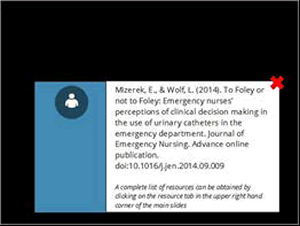
Mizerek E, & Wolf L. (2014) To Foley or not to Foley: Emergency nurses' perceptions of clinical decision making in the use of urinary catheters in the emergency department. Journal of Emergency Nursing. Advance online publication. 2014.
A complete list of resources can be obtained by selecting on Resource tab in the upper right hand corner of the main slides.
This quote represents focus group member responses to questions about education and competency in CAUTI reduction and catheter insertion.
Slide 37
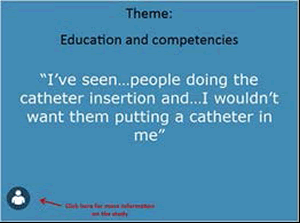
Theme: Education and competencies
"I've seen...people doing the catheter insertion and...I wouldn't want them putting a catheter in me."
Slide 38
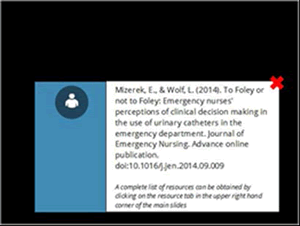
Mizerek E, & Wolf L. (2014) To Foley or not to Foley: Emergency nurses' perceptions of clinical decision making in the use of urinary catheters in the emergency department. Journal of Emergency Nursing. Advance online publication. 2014.
A complete list of resources can be obtained by selecting the Resource tab in the upper right hand corner of the main slides.
This quote represents focus group member responses to questions about education and competency in CAUTI reduction and catheter insertion.
Slide 39

Theme: Education and competencies
"...there are technique issues even with a lot of the seasoned staff."
Slide 40
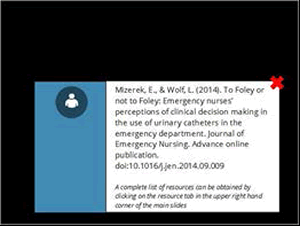
Mizerek E, & Wolf L. (2014) To Foley or not to Foley: Emergency nurses' perceptions of clinical decision making in the use of urinary catheters in the emergency department. Journal of Emergency Nursing. Advance online publication. 2014.
A complete list of resources can be obtained by selecting the Resource tab in the upper right hand corner of the main slides.



